Bigender: Meaning, History and Flag Variations
 Bigender flag
Bigender flag
Those who identify as bigender define their gender identity as a mix between two genders.
They can be more or less drawn to one of the genders compared to the other, or their identity could consist of a balance between both genders. The bigender identity doesn’t necessarily correspond to the gender binary; a bigender person can identify as male and non-binary, for example. It shouldn’t be confused for bisexuality either, as it is not a sexual orientation.
If bigender people feel differently with the passing of time, meaning their identity fluctuates between genders, they could be genderfluid; if they identify with multiple genders, rather than just two, they could be multigender.
Table of Content
Bigender History
The term bigenderist was recorded for the first time in Abstracts of a Symposium on Gender Issues for the 90s, published in 1988. It associated bigenderism with androgyny by defining Androgyne as “a person who can comfortably express either alternative gender role in a variety of socially acceptable environments. (Includes bigenderist.)”
In 1995, Gary Bowen explained, in A Dictionary of Words for Masculine Women: “I don’t like the implication of ‘trans’ meaning ‘to pass through,’ which implies that there are only two genders (…) I am about 70% male and 30% female (…)”. And so the same document included a description of bigendered people as “having two genders, exhibiting cultural characteristics of male and female roles.”
More recently, in the year 2012, neuroscientist Vilayanur Ramachandran performed a study in which it was found that 23 out of the 32 bigender participants fluctuated between the female and male genders various times in the same week. They also placed bigenderism in the transgender category.
Bigender Flag and Symbols
There is no official bigender flag, but there were many contributions from within the bigender community.
The original bigender flag was created around the year 2014 and has a questionable reputation. Pink shades reference the female gender, blue shades reference the male gender, purple shades reference non-binary genders, and the white color turning grey represents neutral genders.
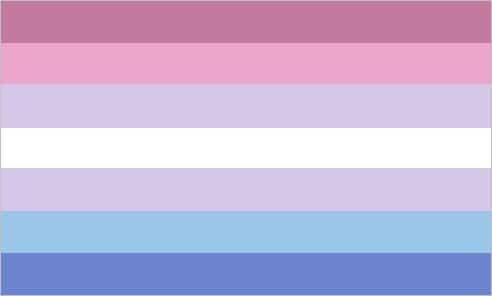 The original bigender flag by no-bucks-for-this-doe
The original bigender flag by no-bucks-for-this-doe
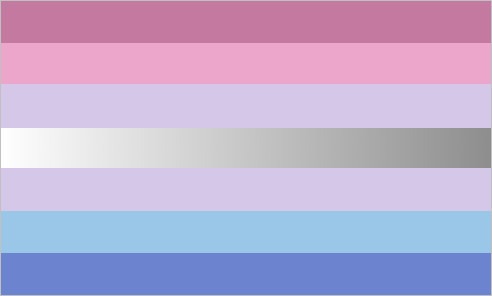
In 2015, several other bigender flags emerged. One of them was by an unknown creator, in which the source did not specify the meaning of the colors. It is estimated that the original references remain. Another flag used purple to reference the non-binary gender, darker purple to reference the male gender, lighter purple to reference the female gender, grey to reference those who partly identify with non-binary genders, and white to reference those who are genderfluid. The third flag created that year did not specify any meanings for the colors.
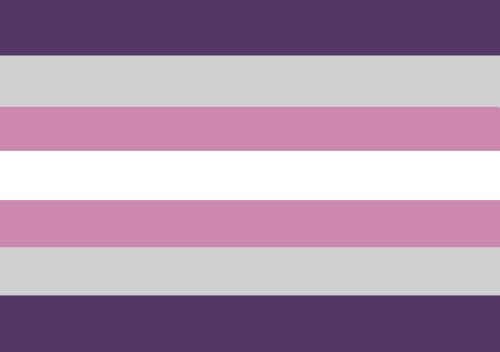 Bigender flag by pastelflowers.
Bigender flag by pastelflowers.
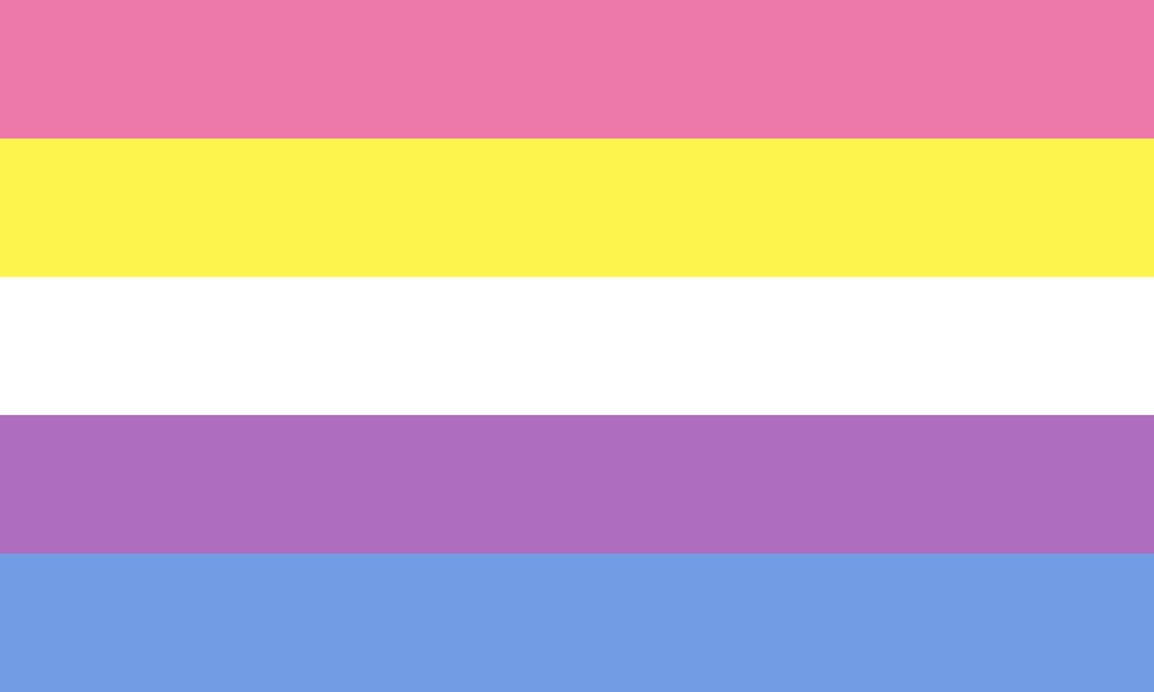 Common bigender flag
Common bigender flag
 Bigender flag by asteri-sympan
Bigender flag by asteri-sympan
More recently, in 2019, several other flags for the bi gender people appeared. The first was posted on Reddit with no color description or meanings attached. The second flags were published on Tumblr and presented new colors: red shades for femininity; reddish-orange representing fluidity and alliance; yellow-orange shades representing a sense of belonging in a broader community; white for the non-binary people; greenish-yellow for highlighting the presence of the bigender person; blue shades for masculinity.
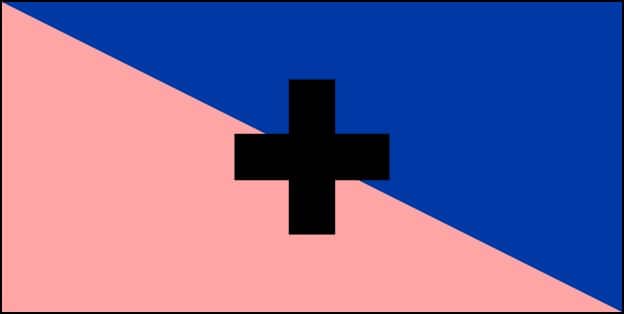 Bigender flag by KYmicrophone
Bigender flag by KYmicrophone
 Bigender flag by lestis with black and brown stripes
Bigender flag by lestis with black and brown stripes
 Bigender flag by Lestis
Bigender flag by Lestis
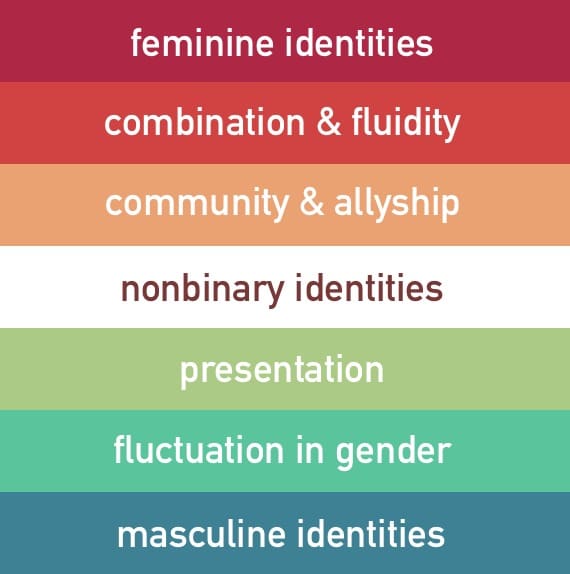
In 2020, another bigender flag was recognized on Tumblr. Color meanings are essentially the same, only this time tones are used to showcase intensity: pink for femininity, blue for masculinity, yellow for the non-binary genders, purple representing mixed genders, and white for the placement of the bigender on the non-binary sphere.
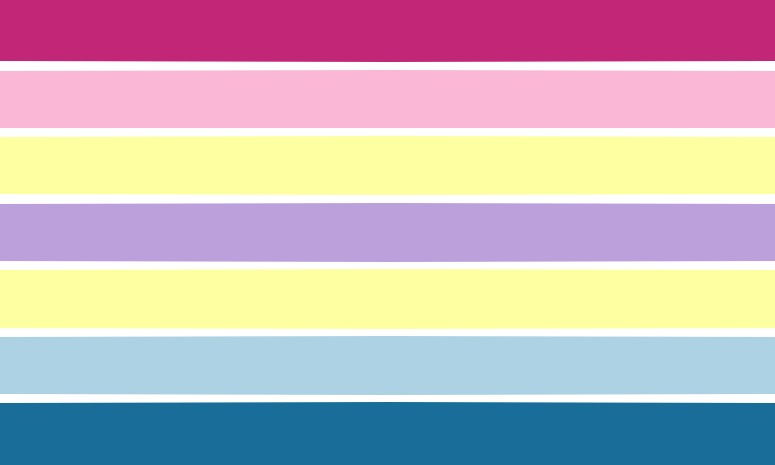 Bigender flag by zombifisgender/mogaiphobic
Bigender flag by zombifisgender/mogaiphobic
A brand new bigender flag was posted on Instagram in 2021 and consists of a reorder of the original design’s colors, with the addition of a compass-style rose of the winds, meant to symbolize versatility and flexibility.
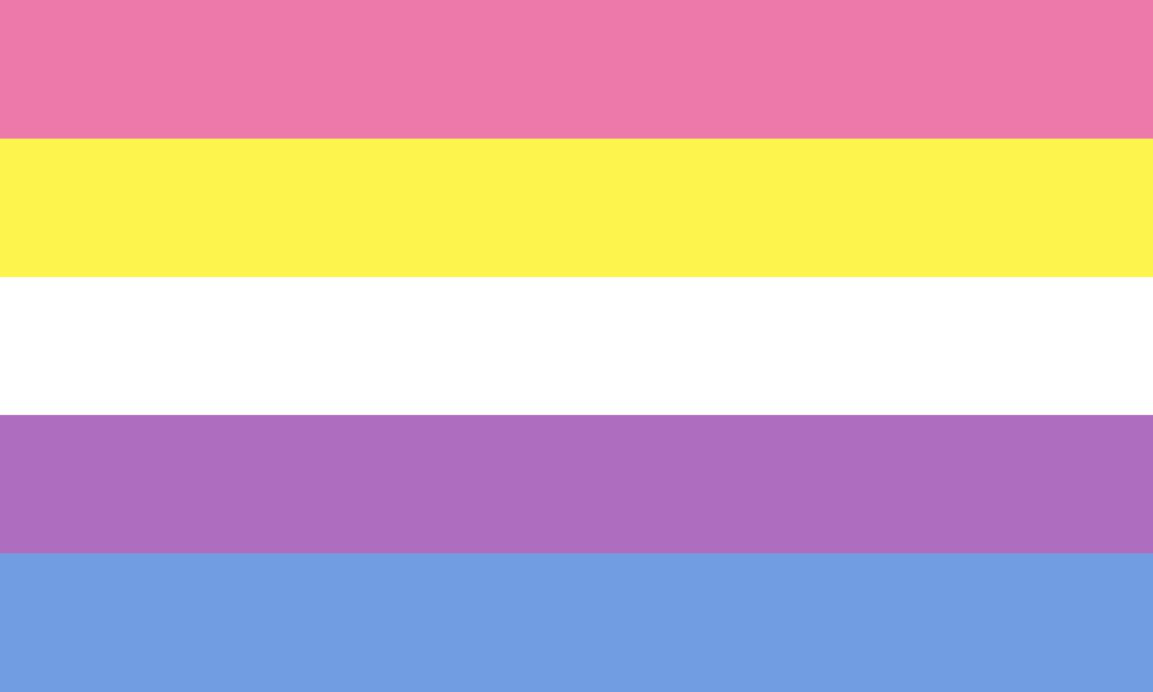 New bigender flag
New bigender flag
As for symbols, the bigender is commonly represented by merging the Mars and Venus symbols, embodying masculinity and feminity joined together.
 Bigender symbol
Bigender symbol
Bigender Pronouns
Being bi gendered could be defined as having two distinct gender identities in one. Whether it feels like a double gender or an alternating gender identity, the bigender person typically identifies with male and female roles.
In an article, Outright International explains how pronouns are part of one’s gender expression and not their gender identity. While identity describes how someone feels about themselves, expression demonstrates how they want to show themselves to others.
In the same way, not all bigender people express masculine and feminine inclinations the same way, or at the same time – they just recognize them both as part of their identity. This explains the variety of pronouns bigender individuals use and why no specific set of pronouns should be assigned to the bigender person without asking first.
As Alexia Denker clarifies on Quora, if someone identifies with the female and male genders, this person’s pronouns can be “he/she,” but another bigender person can prefer using “they” if their second gender is non-binary. It’s all up to the person themselves to choose the set of pronouns they feel most comfortable with!
Differences and Comparison
Bigender and Genderfluid
Genderfluidity is an umbrella term that is not entirely separate from bigenderism. Bigender individuals can actually be genderfluid as well, and the other way around. So what differentiates them?
The genderfluid person sees their gender identity fluctuate and vary over time and context, not necessarily assimilating two or multiple genders at once. They can identify as male at a certain stage of their lives and as non-binary later on.
Bigender people, on the other hand, can express their gender differently according to the situation or mood, but their double gender identity usually remains constant.
Genderfluidity and bigenderism can converge, for example, when the person fluctuates between two gender identities throughout their life. They can also converge when bigender individuals see one or both of their gender inclinations be replaced with another over time.
Bigender and Agender
While bigender means having two genders or double genders, being agender implies having no gender at all. According to the Merriam-Webster dictionary, agender is “a person whose gender identity is genderless or neutral.”
Bigender and Multigender
Multigenderism is another umbrella term that designates those who identify with various genders – could be two, could be three, or any number. As such, it incorporates bigenderism.
If the multigender person’s gender identity consists of two genders, this person is also bigender.
Bigender and Non-binary
Bigender is a non-binary gender, meaning the latter incorporates the former in a broader category.
The nature of the non-binary genders is the absence of complete identification with either the female or the male genders. Since being bigender means having a gender identity in which two genders are present, bigender people are also non-binary.
Bigender and Bisexual
The confusion between these two terms usually derives from the fact that they share the prefix “bi,” meaning two, or bilateral. It’s important to understand, though, that they are not synonyms.
Bisexuality is one of many sexual orientations; bigender is one of many gender identities. As sexual orientation concerns sexual attraction towards others and gender identity concerns one’s internal view of themselves, these two terms relate to entirely different aspects of a person’s personality.
Bigender and Androgyne
An androgynous person (or androgyne) is someone who rejects society’s expectations of how they should act according to their biological sex, and expresses their gender identity without any sort of ties to gender roles or norms. They are simultaneously female and male, although sometimes to different extents.
Bigenderism differs from androgyny in the sense that bigender people identify with two genders, whereas androgyne people have one gender that does not follow stereotypes or prejudices.
Bigender and Transgender
Transgender isn’t just meant to describe a transition from the female to the male gender or the other way around. Being transgender means having a gender identity that differs from one’s biological sex.
As non-binary people are transgender, and as bigender belongs in the non-binary category, being bigender also means being transgender.
How do I know if I’m bigender?
Gender identity is a sensitive topic for many – it can take a while for you to fully understand it, and even longer for you to comfortably express it.
The first step in exploring your individuality is accepting your spontaneous thoughts and not censoring your feelings towards your own gender.
Your anatomy does not dictate your gender identity
The sex you were assigned at birth should not define your gender identity or your gender expression. Figuring out your individuality should come from within and not from wanting to fulfill others’ expectations based on your anatomy.
Deconstructing the gender binary
There is a whole world beyond the male and female genders. Gender is a spectrum, not a two-option lottery. Even if we put masculinity on one side of the scale and femininity on the other, the in-betweens are endless.
Tearing down prejudice is the way to clarity
The less you abide by society’s norms or expectations of how you should feel about yourself or behave towards others, the more you will connect with your individuality.
How does it feel like – being bigender?
Being bigender can be described as having two personas or having a two-sided character, in which these two parts are not ambivalent, but instead, coexist harmoniously. One of the sides can be more present and weigh more on how you show yourself to the world, or both parcels can similarly influence your personality.
With which genders does the bi-gender person identify?
A significant portion of the bigender community identifies with the female and male genders, but non-binary identities are also very much present. Every bigender person can have a different pair of genders.
How do bigender people style their appearance?
Gender expression is even more diverse among bi-gendered individuals, so it’s impossible to say or give a detailed description of how bigender individuals dress, act, or showcase themselves to the world. In this sense, they can be compared to androgynous people, as they can appear both female and male simultaneously, one at a time, or even neither.
How to support a bigender person
Tolerance, empathy, and solid support groups are always crucial in everyone’s discovery of their own gender identities. Expressing one’s bigender identity in a healthy and confident way also depends on having accepting environments, where the person can freely be themselves.
Open up the discussion about bigender
Make sure the person knows you feel comfortable talking about the topic and that you’re interested in finding out more about how they feel towards their gender. If they know the subject matter doesn’t bother you, they’ll feel a lot more comfortable around you, and consequently, start being more spontaneous and confident.
Compliment changes in appearance
Bigender people often change their style and may present themselves differently according to the context. They can sometimes appear more feminine, other times appear more masculine, look like both in one, or even neither. The important thing is to see these changes as being part of the bigender individual’s personality, and even praise them – it will only help the person express themselves more genuinely.
Be there for them when things don’t go so well
Some mentalities can be a bit limited when it comes to gender identities, which can cause some awkward encounters every now and then. But that’s normal. As long as you show that you stand by them even when things go wrong, they’re sure to overcome anything that comes their way.
Encourage them to be themselves
A great way to show your unconditional support is to treat their style and expression naturally. Rather than focusing on it too much, being casual about it is also recommended to make sure the person feels truly accepted. Spontaneous compliments and occasional words of encouragement are a great idea, too!
Promote acceptance in your surroundings
Whether you’re friends or family with a bigender person, you can be an advocate for their right to be respected. Even when the person themselves isn’t present, defend them. When someone addresses them using an incorrect pronoun, kindly correct them. Your words and actions will have a great impact on the way the people around you perceive the bigender person.
Ask relevant questions and show you care about the answers
From getting to know their pronouns to feeling accustomed to their changes in presence, questions are a great way to whip up a sense of understanding between you and the bigender individual. But beyond asking, it’s important to demonstrate that you empathize with the explanations and that they make sense to you.
Did you know…?
The term bigenderism has two entirely different meanings. For one, it can stand for the theory that recognizes only the gender binary (male and female, exclusively), claims that gender identity cannot differ from one’s assigned sex at birth, and enforces that masculinity prevails over feminity. For another, it naturally refers to being bigender.
Share this post:
What do you think?
 Bigender flag
Bigender flag


